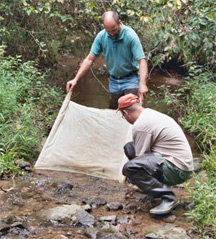Finding %EPT
 One way to do an RBA (Rapid Bioassessment) is to separate the elite insects (EPT) from the riffraff (midges, blackflies, aquatic worms, and everyone else). To do that, you use a net to get a sample from the bottom of the stream, pick out all the invertebrates you can see with the naked eye, and figure out what kind each one is. Then you calculate what percentage of the all the species are EPT taxa.
One way to do an RBA (Rapid Bioassessment) is to separate the elite insects (EPT) from the riffraff (midges, blackflies, aquatic worms, and everyone else). To do that, you use a net to get a sample from the bottom of the stream, pick out all the invertebrates you can see with the naked eye, and figure out what kind each one is. Then you calculate what percentage of the all the species are EPT taxa.
For example: Let’s say you found 5 species altogether:
| Taxa | EPT??? | # of individuals |
|---|---|---|
| striped stonefly | yes | 2 |
| Rheotanytarsus (chironomid) | -- | 17 |
| Eukiefferiella (chironomid) | -- | 15 |
| Orthocladius (chironomid) | -- | 18 |
| simulid blackfly | -- | 6 |
You might think that you need to add up all of those individuals... but NO! It's much easier. Just count the number of EPT taxa, divide by the total number of taxa, and multiply by 100. So...
%EPT = 1 / 5 * 100 = 20%
The higher the EPT index, the better! 15% is quite low, but 30% or more is quite high. So, the 20% we got here probably indicates a very good, unpolluted site. However, every area is different, so it is important to compare the stream to a really good ("pristine") stream nearby. Let's do that now.
| Taxa | EPT??? | # of individuals |
|---|---|---|
| striped stonefly | ?? | 6 |
| net-spinning caddisfly | ?? | 7 |
| flathead mayfly | ?? | 3 |
| odonate (dragonfly) | ?? | 1 |
| Eukiefferiella (chironomid) | ?? | 5 |
| Orthocladius (chironomid) | ?? | 8 |
| simulid blackfly | ?? | 2 |
What is the %EPT in the pristine stream above
(To make this problem interactive, turn on javascript!)
- I need a hint ... : Count the number of mayfly, stonefly, and caddisfly species.
- ...another hint ... : There are 3 EPT species out of 7 total.
- ...another hint ... : To find the percent, use EPT/total * 100.
I think I have the answer:43%
So in our tiny example above,
polluted stream: richness = 5, EPT=20%
pristine stream: richness = 7, EPT=43%
You can see that the pristine stream is has a wider range of habitat (=more species) AND it's a better environment for species that don't tolerate pollution (=higher EPT). So it wins all around.
You might say "but there were more insects in the polluted stream!", which is true. Remember, though, that chironomids in particular are tiny compared to the EPT taxa -- although they are a big item in fish diets, it takes a lot of them to get full.
Copyright University of Maryland, 2007
You may link to this site for educational purposes.
Please do not copy without permission
requests/questions/feedback email: mathbench@umd.edu